Have you ever thought about animals whose names start with E? From eagles in the sky to earthworms underground, animals with E show how diverse nature can be.
These creatures live in the air, forests, and seas, proving the richness of life on our planet.
Did you know some of these animals can do amazing things? Eastern brown snakes are among the most venomous, while echidnas are among the few mammals that lay eggs.
By learning about these 30 animals with E, you’ll learn cool facts about where they live, what they do, and what makes them special.
If you like animals or want to know more about wildlife, this list will teach you new things and keep you interested.
Animals Beginning With E
The letter E introduces us to a diverse group of animals, each with unique and mesmerizing characteristics.
This section explores creatures that showcase nature’s variety, from the powerful eagle to the egg-laying echidna.
These animals in the air, forests, and oceans show us how varied life is on Earth.
Join us as we find interesting facts and insights about these remarkable E-named species worldwide.
1. Eagle

Eagles are large birds of prey with hooked beaks, strong talons, and keen eyesight. They typically have dark brown bodies and wings, with lighter-colored heads.
Adult bald eagles can reach heights of 3 feet and wingspans of up to 7.5 feet. Females are usually larger than males, weighing 10-14 pounds, while males weigh 8-9 pounds.
- Region of Habitat: Found on every continent except Antarctica
- Scientific Name: Varies by species (e.g., Haliaeetus leucocephalus for bald eagles)
- Place of Origin: Worldwide distribution
- Feeding Habits: Carnivorous, mainly fish and small mammals
- What Sound They Make: High-pitched whistling or chirping calls
Fun Facts: Eagles have incredible eyesight, about eight times sharper than humans. They can spot prey from over a mile away.
Eagles mate for life and often return to the same nest year after year, adding to it until it can weigh up to a ton. Some eagle species can fly up to 100 miles per hour when diving for prey.
2. Eagle Ray

Eagle rays are cartilaginous fish with flat, disc-like bodies and wide pectoral fins that resemble wings.
They have long, whip-like tails and can grow quite large, with some species reaching widths of up to 10 feet and weighing over 500 pounds.
Their coloration varies, but many have dark backs with white undersides and distinctive spot patterns.
- Region of Habitat: Tropical and warm temperate oceans worldwide
- Scientific Name: Varies by species (e.g., Aetobatus narinari for spotted eagle ray)
- Place of Origin: Coastal waters around the globe
- Feeding Habits: Bottom-feeders, eating mollusks and crustaceans
- What Sound They Make: Generally silent, but may produce low grunts when disturbed
Fun Facts: Eagle rays are known for their graceful swimming style, which resembles the flying motion of birds.
They have venomous spines on their tails for defense but are generally not aggressive towards humans.
These rays often leap out of the water, possibly to remove parasites or as part of mating rituals. Some species can live up to 25 years in the wild.
3. Eared Grebe
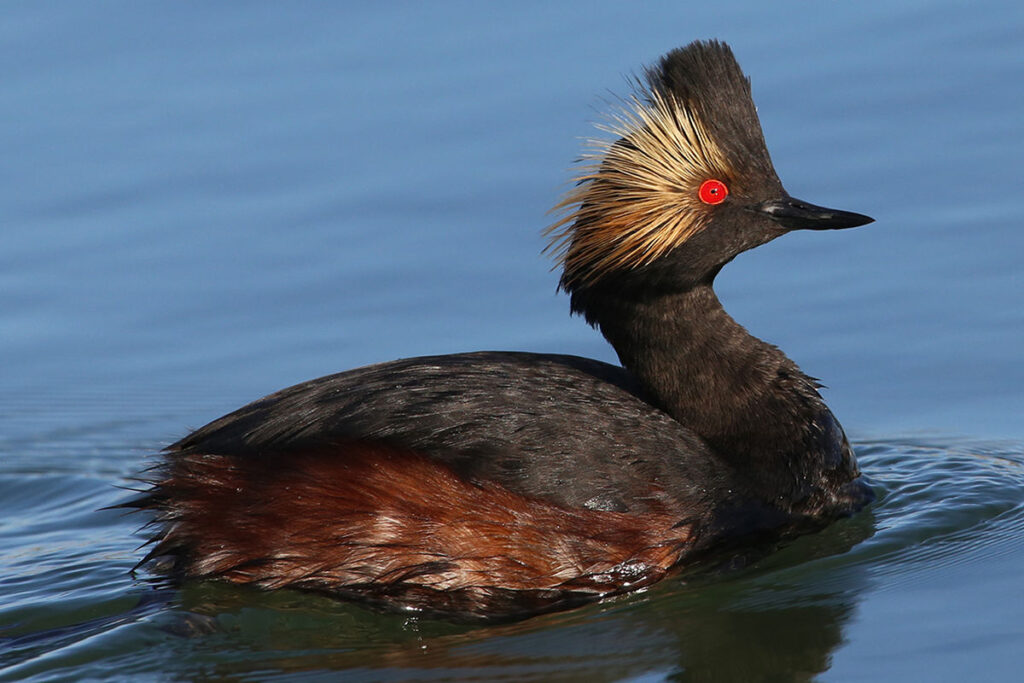
Eared grebes are small waterbirds with compact bodies, short necks, and distinctive red eyes. They display striking black and golden “ear” tufts during the breeding season.
Adults typically measure 12-15 inches in length and weigh between 10-19 ounces.
Their bodies are adapted for diving, with legs positioned far back and lobed toes instead of webbed feet.
Region of Habitat: North America, Europe, Asia, and Africa
- Scientific Name: Podiceps nigricollis
- Place of Origin: Widespread across the Northern Hemisphere
- Feeding Habits: Mainly aquatic insects, small fish, and crustaceans
- What Sound They Make: High-pitched peeping and trilling calls
Fun Facts: Eared grebes often double their body weight before migration and can absorb up to 50% of their flight muscles and internal organs to fuel their journey.
These birds are excellent swimmers and divers but struggle to walk on land due to their leg position. They build floating nests anchored to vegetation in shallow waters.
4. Earless Monitor Lizard
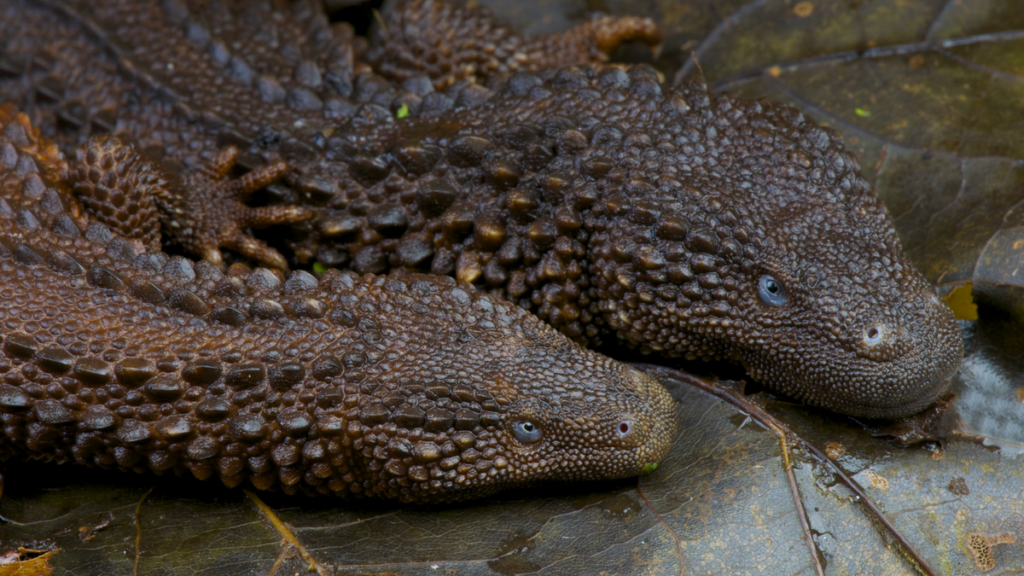
The earless monitor lizard is a rare, semi-aquatic reptile with a long, cylindrical body and short limbs. It lacks external ears, giving it a smooth-headed appearance.
Adults typically reach 16-20 inches long and weigh around 7-14 ounces. Their scales are small and beaded, giving them a rough texture, and their coloration is usually dark brown or grayish.
- Region of Habitat: Borneo
- Scientific Name: Lanthanotus borneensis
- Place of Origin: Northwestern Borneo
- Feeding Habits: Carnivorous, eating small invertebrates and fish
- What Sound They Make: Generally silent, may hiss when threatened
Fun Facts: Earless monitor lizards are so elusive that they were once thought to be extinct.
They have a unique ability to shut down their metabolism and appear unconscious for long periods. These lizards are excellent swimmers and can stay underwater for extended periods.
Due to their rarity and limited habitat, they are highly sought after in the illegal pet trade.
5. Earthworm
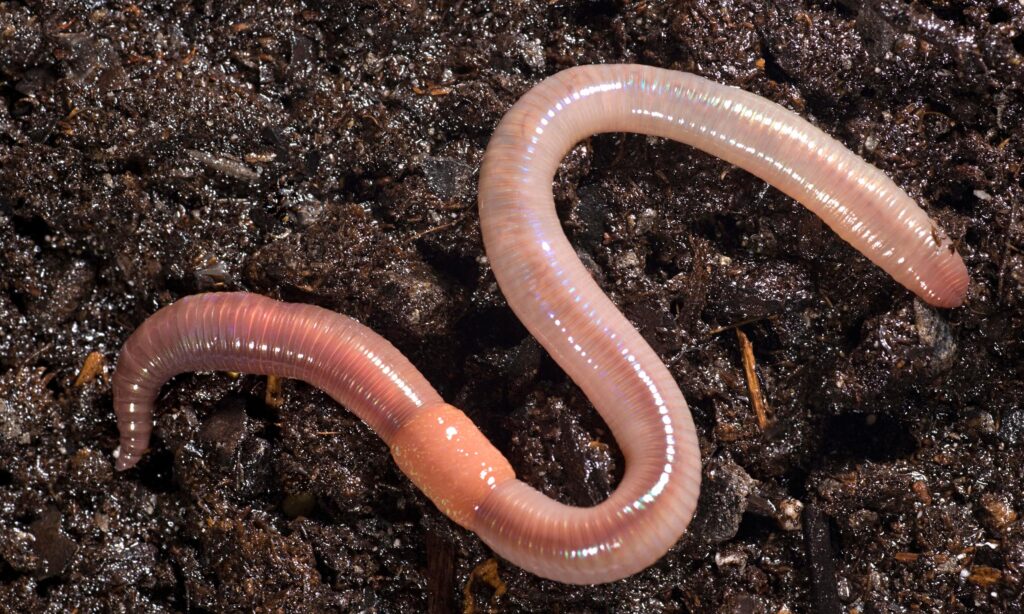
Earthworms are long, cylindrical invertebrates with segmented bodies. They lack eyes and limbs but have small bristles called setae that help them move through the soil.
Most earthworms are 3-8 inches long, but some species can reach lengths up to 14 feet.
Depending on the species and age, earthworms typically weigh between 0.09 and 0.25 ounces.
- Region of Habitat: Found on every continent except Antarctica
- Scientific Name: Varies by species (e.g., Lumbricus terrestris for common earthworm)
- Place of Origin: Widespread globally
- Feeding Habits: Decomposers, consuming organic matter in soil
- What Sound They Make: Silent
Fun Facts: Earthworms play a crucial role in soil health, aerating and enriching it as they burrow. They are hermaphrodites, possessing both male and female reproductive organs.
Earthworms can regenerate lost body segments, though this ability is limited. Some species can live up to 8 years in ideal conditions.
6. Earwig
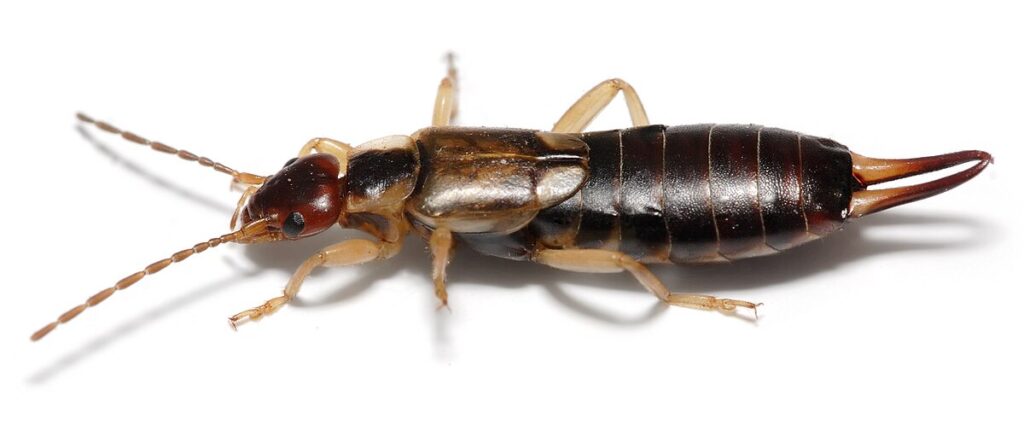
Earwigs are small insects with elongated bodies ranging from 0.2 to 2 inches. They have two pairs of wings and a distinctive pair of pincers at the end of their abdomen.
Most species are dark brown or black. Earwigs have a flattened body shape that allows them to squeeze into tight spaces.
- Region of Habitat: Worldwide, except Antarctica
- Scientific Name: Order Dermaptera
- Place of Origin: Various, depending on the species
- Feeding Habits: Omnivorous, eating plants and other insects
- What Sound They Make: Generally silent, but can produce a faint buzzing sound when flying
Fun Facts: Despite their name, earwigs do not crawl into people’s ears. The pincers are used for defense and to catch prey.
Some species of earwigs show parental care, with mothers tending to their eggs and young nymphs. There are nearly 2,000 different species of earwigs worldwide.
7. East Siberian Laika

The East Siberian Laika is a medium—to large-sized dog breed with a thick double coat.
It typically stands 21-25 inches tall at the shoulder and weighs between 40 and 50 pounds.
These dogs have a wolf-like appearance with erect ears, a curled tail, and almond-shaped eyes.
Region of Habitat: Primarily in Russia
- Scientific Name: Canis lupus familiaris
- Place of Origin: Eastern Siberia
- Feeding Habits: Carnivorous diet should be high in protein
- What Sound They Make: Barks, howls, and makes other vocalizations
Fun Facts: East Siberian Laikas are known for their excellent hunting abilities and ability to track various games.
They have a strong prey drive and are often used to hunt bears and other large animals. These dogs are well-adapted to cold climates and work at temperatures as low as -58°F (-50°C).
8. Eastern Barred Bandicoot

The Eastern Barred Bandicoot is a small marsupial with a pointed snout and large ears.
They measure about 16-19 inches long, including their tail, and weigh between 1.3 and 2.4 pounds.
Their fur is greyish brown with three or four pale bars across their hindquarters, giving them their name.
- Region of Habitat: Formerly widespread in southeastern Australia, now limited to protected areas
- Scientific Name: Perameles gunnii
- Place of Origin: Australia
- Feeding Habits: Omnivorous, eating insects, grubs, and some plant matter
- What Sound They Make: Generally quiet, may make soft grunting noises
Fun Facts: Eastern Barred Bandicoots can cover three feet of ground in a single leap. They dig distinctive, cone-shaped holes in the ground while foraging for food.
These marsupials are nocturnal and solitary, coming together only to mate. They are currently considered endangered due to habitat loss and predation by introduced species.
9. Eastern Bluebird
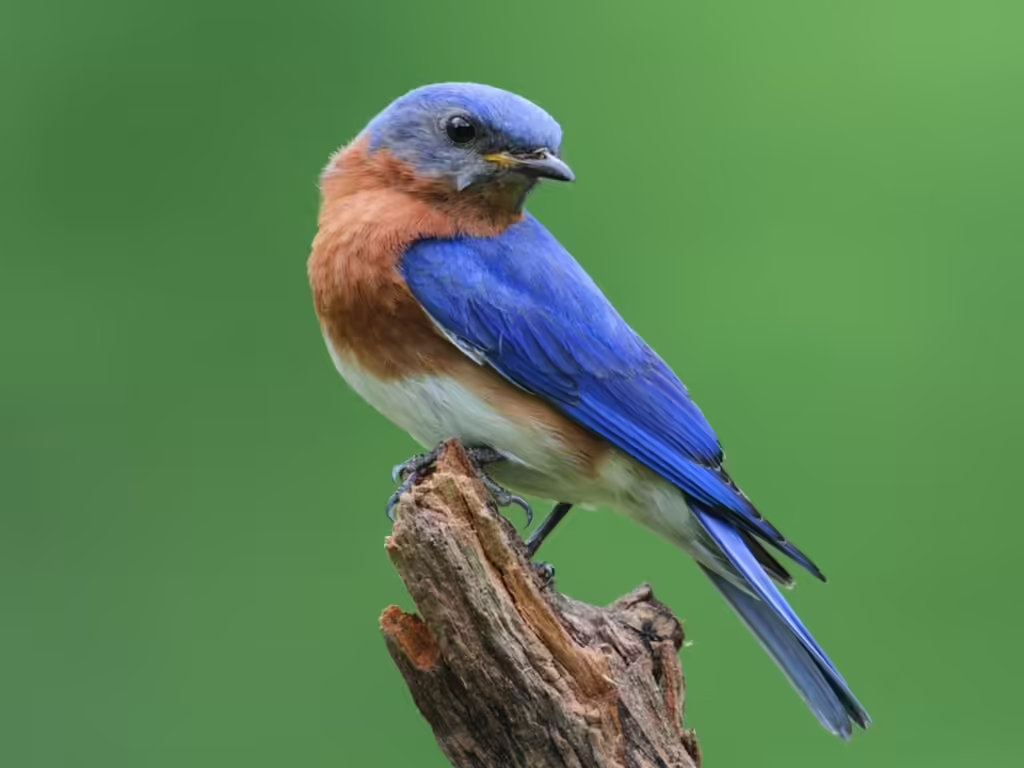
Eastern Bluebirds are small thrushes with bright blue upperparts, rusty-red breasts, and white bellies.
Males are more brightly colored than females. They measure about 6.3-8.3 inches in length and have a wingspan of 9.8-12.6 inches. These birds typically weigh between 0.9-1.2 ounces.
- Region of Habitat: Eastern North America
- Scientific Name: Sialia sialis
- Place of Origin: North America
- Feeding Habits: Omnivorous, eating insects and small fruits
- What Sound They Make: Soft, low-pitched warbling song
Fun Facts: Eastern Bluebirds have a unique hunting technique where they drop straight down on their prey from their perch, similar to the hunting style of leopards.
They are cavity nesters and readily accept artificial nest boxes. Bluebirds can spot caterpillars and insects in tall grass at distances human eyes can’t perceive.
10. Eastern Box Turtle
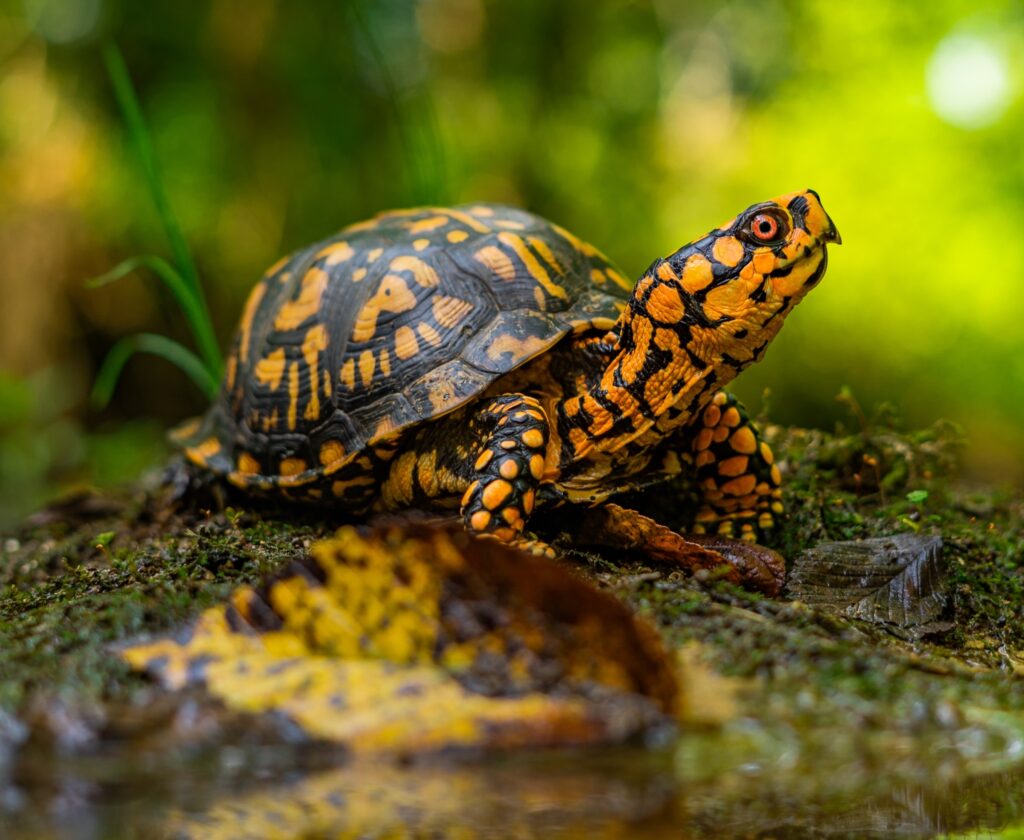
Eastern Box Turtles are small to medium-sized turtles with a high, domed shell that can be closed completely to protect the animal.
They typically measure 4.5-6 inches in length. The shell color varies but often features intricate yellow, orange, or olive patterns on a dark background.
- Region of Habitat: Eastern United States
- Scientific Name: Terrapene Carolina
- Place of Origin: North America
- Feeding Habits: Omnivorous, eating a variety of plants and small animals
- What Sound They Make: Generally silent, may hiss when threatened
Fun Facts: Eastern Box Turtles can regenerate their shells if damaged. They can live for over 100 years in the wild.
These turtles have a good sense of direction and will often spend their entire lives in an area of just a few acres. They are known for their longevity and slow metabolism.
11. Eastern Brown Snake
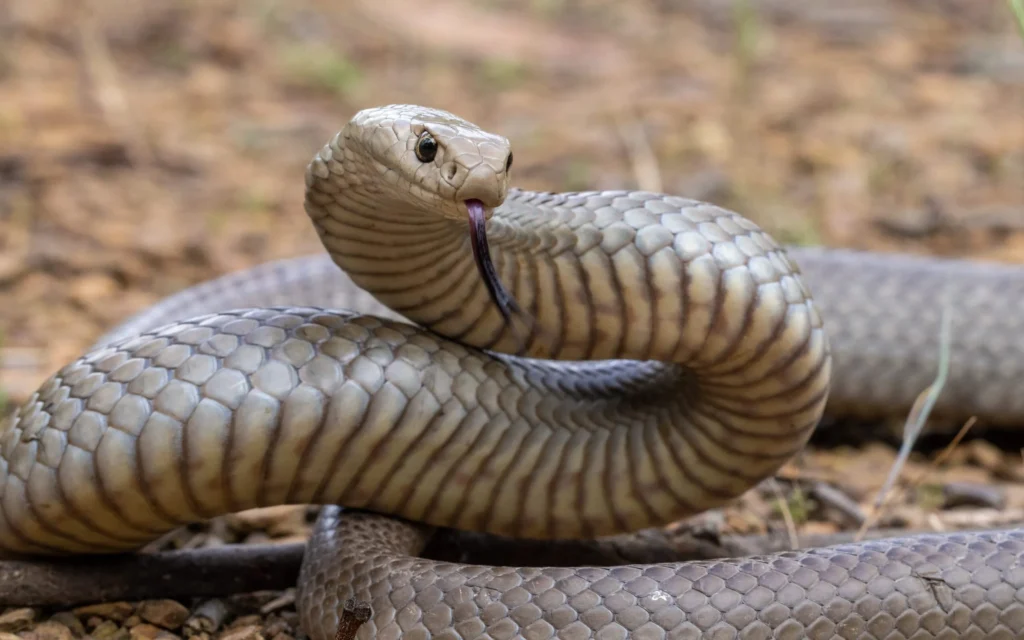
The Eastern Brown Snake is a slender, fast-moving snake that can grow up to 7 feet long. Its coloration varies from pale brown to almost black, with a cream or yellow underside.
The snake’s small head is barely distinguishable from its neck.
- Region of Habitat: Eastern and Central Australia
- Scientific Name: Pseudonaja textilis
- Place of Origin: Australia
- Feeding Habits: Carnivorous, primarily eating small mammals
- What Sound They Make: Can produce a warning hiss when threatened
Fun Facts: Eastern Brown Snakes are considered one of the most venomous land snakes in the world.
They are known for their speed and agility, capable of moving up to 12 miles per hour. Despite their dangerous reputation, they generally try to avoid confrontation with humans and will only bite as a last resort.
12. Eastern Chipmunk

Eastern Chipmunks are small, striped rodents with distinctive cheek pouches. They typically measure 8-10 inches long, including their tail, and weigh 2-5 ounces.
Their fur is reddish-brown with five dark stripes running down their back, alternating with lighter stripes.
- Region of Habitat: Eastern North America
- Scientific Name: Tamias striatus
- Place of Origin: North America
- Feeding Habits: Omnivorous, eating nuts, seeds, fruits, and insects
- What Sound They Make: High-pitched chip-chip-chip calls
Fun Facts: Eastern Chipmunks are excellent climbers and can descend trees headfirst. Their name comes from an Ojibwe word meaning “one who descends trees headfirst.”
They can stuff their expandable cheek pouches with food until they’re three times the size of their head. These rodents hibernate in winter but wake up periodically to snack on stored food.
13. Eastern Coral Snake
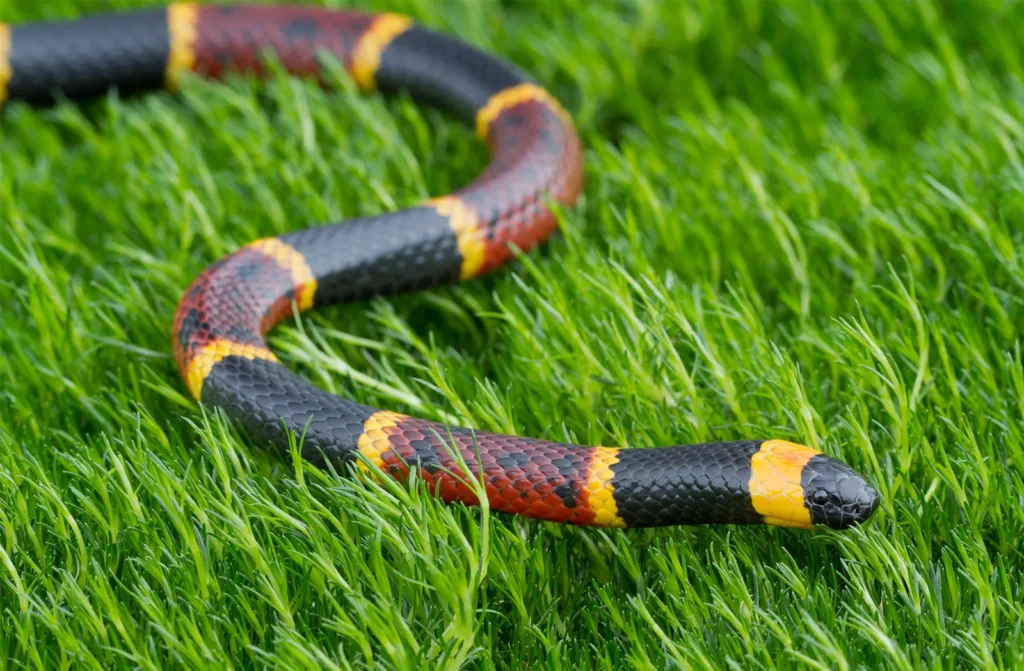
Eastern Coral Snakes are slender, brightly colored snakes with a pattern of red, yellow, and black bands encircling their body.
They typically grow to lengths of 20-30 inches. Their head is black, and they have a blunt snout.
- Region of Habitat: Southeastern United States
- Scientific Name: Micrurus fulvius
- Place of Origin: North America
- Feeding Habits: Carnivorous, primarily eating other snakes and lizards
- What Sound They Make: Generally silent, may produce a soft rattle with their tail when threatened
Fun Facts: Eastern Coral Snakes have potent venom but rarely bite humans due to their reclusive nature.
They have a memorable rhyme to distinguish them from non-venomous lookalikes: “Red touch yellow, kill a fellow; red touch black, friend of Jack.”
These snakes are shy and prefer to hide rather than confront potential threats.
14. Eastern Cottontail
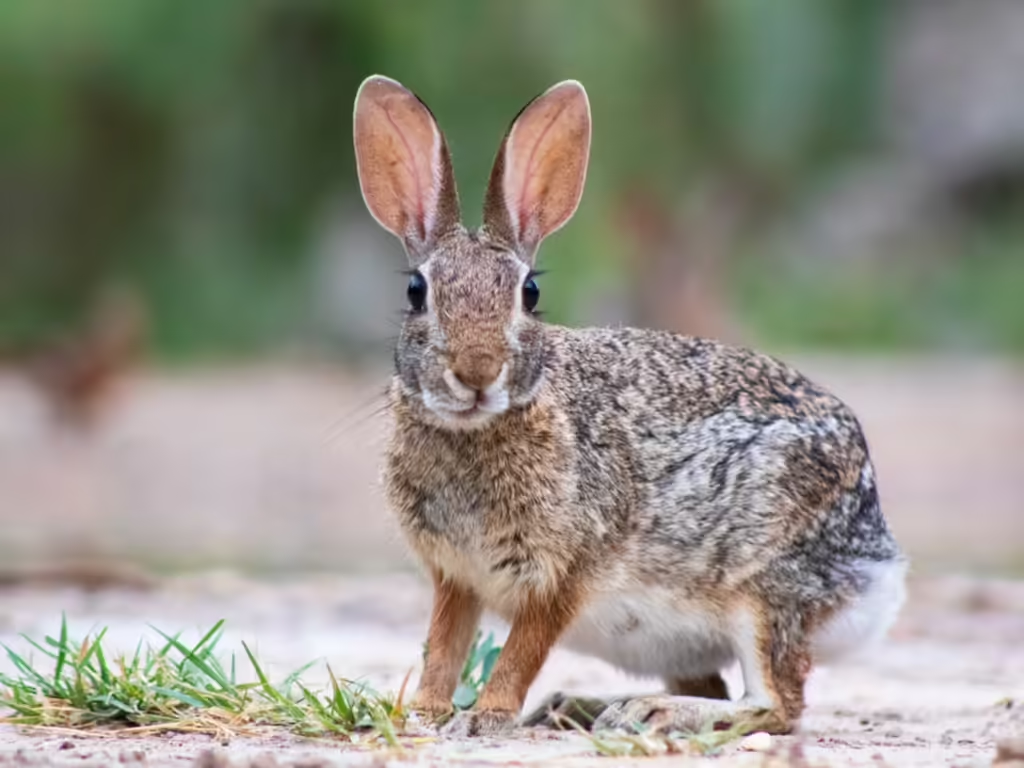
Eastern Cottontails are medium-sized rabbits with soft, greyish-brown fur, large ears, and a distinctive white tail that resembles a cotton ball.
They measure about 15-19 inches in length and weigh between 2-4 pounds. Their hind feet are significantly larger than their front feet.
- Region of Habitat: Eastern and south-central United States, eastern Mexico, Central America, and northern South America
- Scientific Name: Sylvilagus floridanus
- Place of Origin: North America
- Feeding Habits: Herbivorous, eating a variety of plants
- What Sound They Make: Generally silent, may squeal when in distress
Fun Facts: Eastern Cottontails can run up to 18 miles per hour to escape predators. They are prolific breeders, with a single female capable of producing up to 35 kits annually.
These rabbits are crepuscular, meaning they are most active at dawn and dusk. They rarely need to drink water, getting most of their hydration from the plants they eat.
15. Eastern Diamondback Rattlesnake
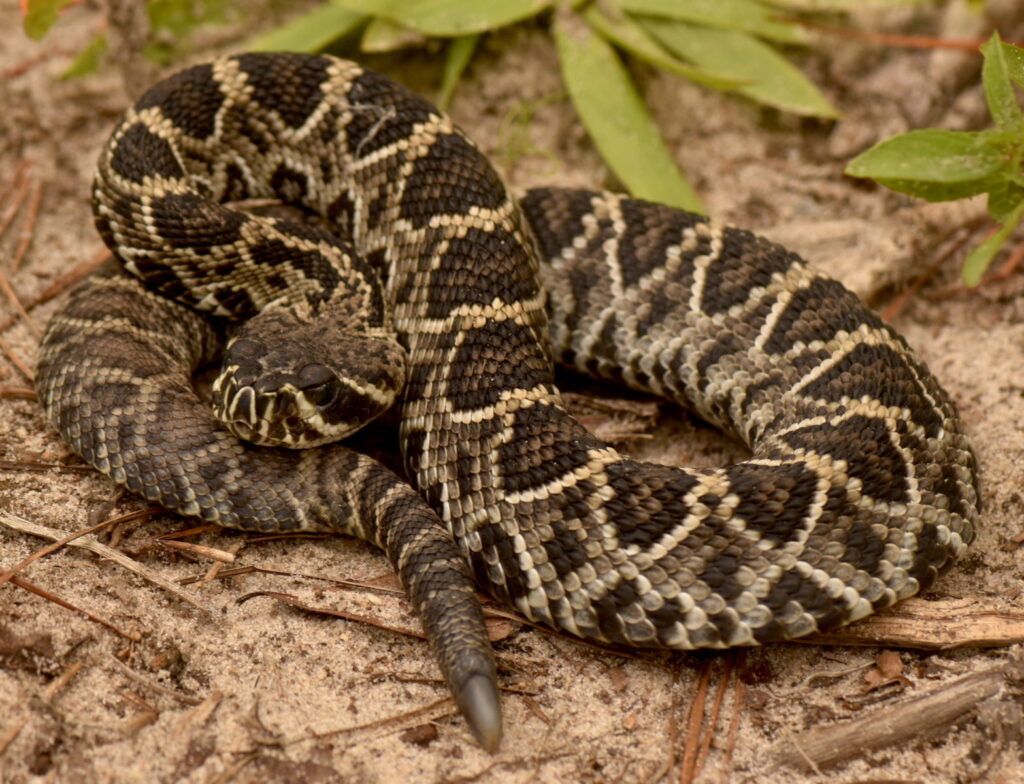
The Eastern Diamondback Rattlesnake is the largest venomous snake in North America, reaching lengths of up to 8 feet.
It has a thick, heavy body with a distinctive diamond pattern along its back. Its coloration is typically brown, tan, or yellowish, with darker diamond shapes outlined in black.
- Region of Habitat: Southeastern United States
- Scientific Name: Crotalus adamanteus
- Place of Origin: North America
- Feeding Habits: Carnivorous, primarily eating small mammals and birds
- What Sound They Make: Produces a distinctive rattle sound with its tail when threatened
Fun Facts: Eastern Diamondback Rattlesnakes are known for their potent venom and large size. They can accurately strike at up to one-third of their body length.
The number of segments in their rattle does not accurately indicate age, as they acquire new segments each time they shed their skin.
These snakes play an important role in controlling rodent populations.
16. Eastern Dobsonfly
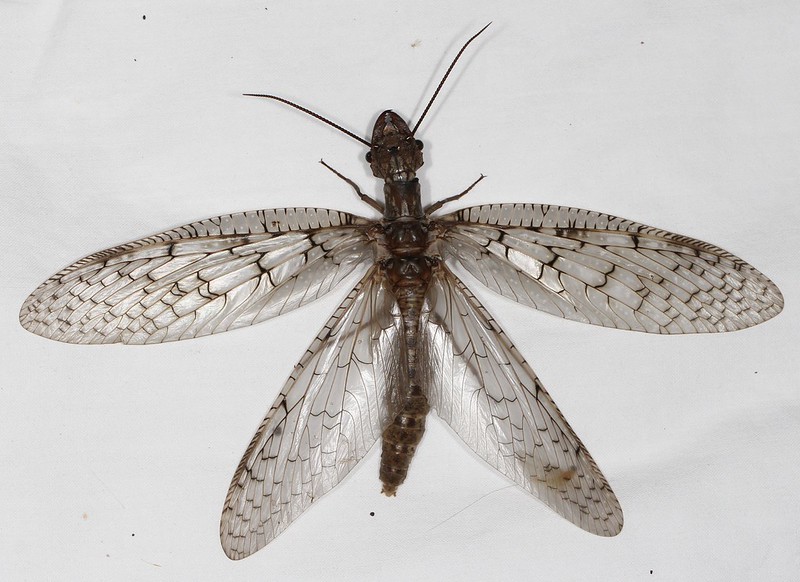
Eastern Dobsonflies are large, intimidating insects with long, slender bodies and large, translucent wings.
They can reach lengths up to 5 inches, with males having exceptionally long, curved mandibles. Their body color is typically dark brown or black.
Region of Habitat: Eastern North America
- Scientific Name: Corydalus cornutus
- Place of Origin: North America
- Feeding Habits: Adults rarely feed; larvae are predatory aquatic insects
- What Sound They Make: Adults can produce a loud buzz when flying
Fun Facts: Despite their fearsome appearance, adult Eastern Dobsonflies are harmless to humans and only live for about a week.
Males’ large mandibles are used for courtship displays and cannot effectively bite. Their aquatic larvae, known as hellgrammites, are popular fishing bait.
The presence of dobsonfly larvae in a water body often indicates good water quality.
17. Eastern Fence Lizard
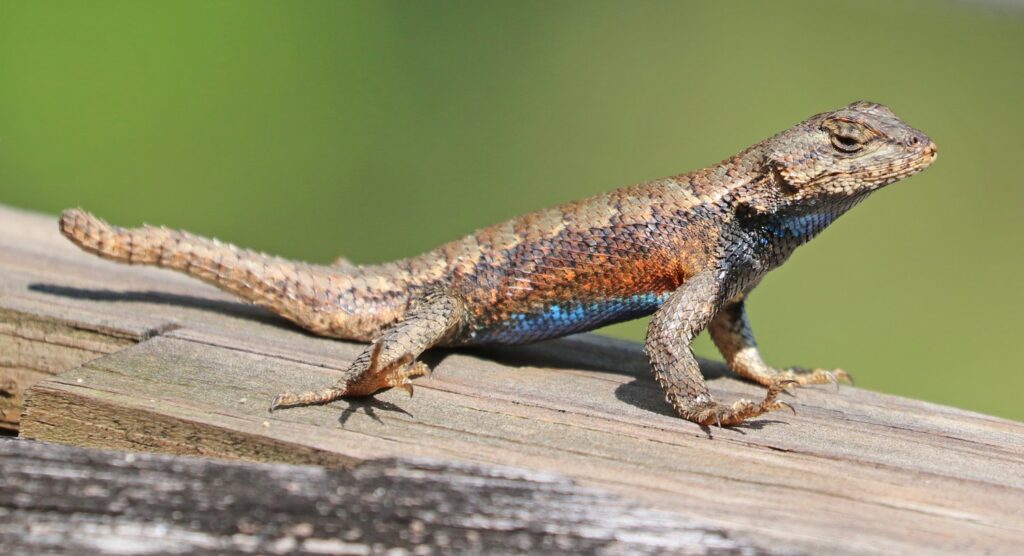
Eastern Fence Lizards are medium-sized lizards with rough, keeled scales that give them a spiny appearance. They typically measure 4-7.5 inches in length.
Their coloration is usually grey or brown with darker undulating crossbands. Males often have bright blue patches on their throat and belly.
Region of Habitat: Eastern and Central United States
- Scientific Name: Sceloporus undulatus
- Place of Origin: North America
- Feeding Habits: Insectivorous, eating a variety of small invertebrates
- What Sound They Make: Generally silent, may produce a soft hiss when threatened
Fun Facts: Eastern Fence Lizards can change color slightly to better blend with their surroundings.
Males perform push-up displays to defend their territory and attract mates. These lizards are excellent climbers and are often seen basking on fences, trees, and rocks.
They play a role in controlling insect populations in their habitats.
18. Eastern Glass Lizard
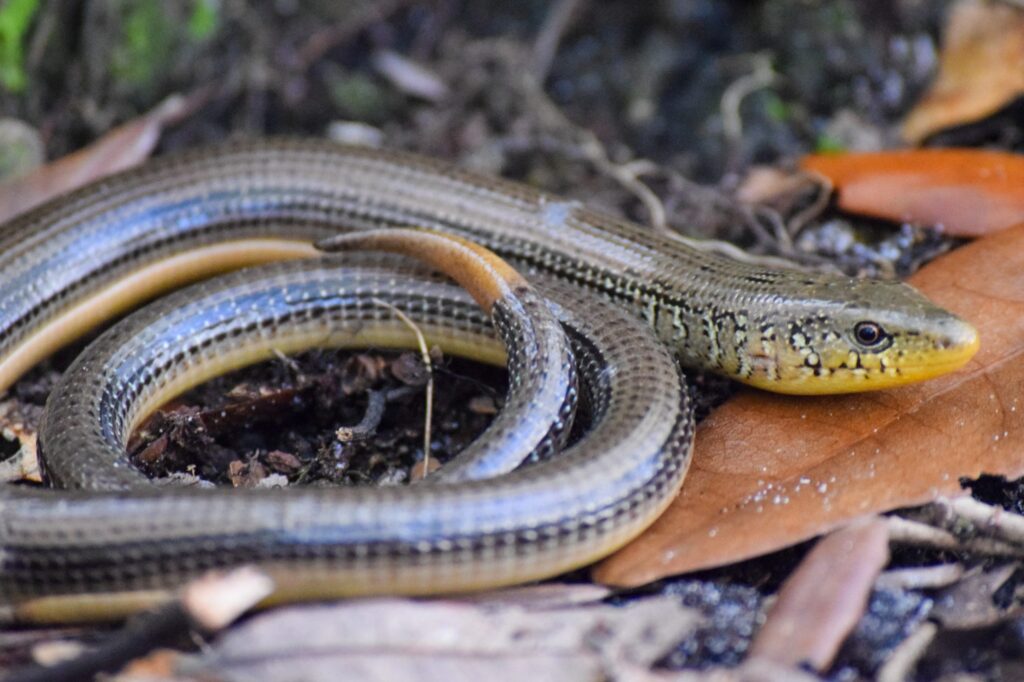
Despite its name, the Eastern Glass Lizard is a legless lizard, not a snake. It can grow up to 42 inches in length and has a long, cylindrical body covered in smooth scales.
Its coloration is typically brown or greenish, with darker stripes or spots along its sides.
- Region of Habitat: Southeastern United States
- Scientific Name: Ophisaurus ventralis
- Place of Origin: North America
- Feeding Habits: Carnivorous, eating insects, spiders, and small vertebrates
- What Sound They Make: Generally silent, may hiss when threatened
Fun Facts: Eastern Glass Lizards get their name from their ability to “break” their tail into several pieces when caught by a predator, similar to how glass shatters.
Unlike snakes, they have eyelids and external ear openings. When they lose their tail, they can grow a new one, but it’s usually shorter and lacks the markings of the original.
19. Eastern Gorilla

Eastern Gorillas are the largest living primates. Adult males, known as silverbacks, can reach heights of up to 5.6 feet when standing upright and weigh up to 440 pounds.
Females are smaller, typically weighing around 220 pounds. They have black fur, a broad chest, and a distinctive sagittal crest on their skull.
- Region of Habitat: Mountainous forests of central Africa
- Scientific Name: Gorilla beringei
- Place of Origin: Africa
- Feeding Habits: Herbivorous, primarily eating leaves, shoots, and fruits
- What Sound They Make: Various vocalizations, including grunts, roars, and screams
Fun Facts: Eastern Gorillas share about 98% of their DNA with humans. They live in family groups led by a dominant silverback male.
Despite their intimidating size, they are generally peaceful animals. Eastern Gorillas are critically endangered due to habitat loss and poaching.
20. Eastern Gray Squirrel

Eastern Gray Squirrels are medium-sized rodents with soft, thick fur, typically a mix of gray and brown.
They have a distinctive bushy tail that is almost as long as their body. Adults measure about 9-12 inches in length (not including the tail) and weigh between 14-21 ounces.
- Region of Habitat: Eastern North America, also introduced to parts of Europe.
- Scientific Name: Sciurus carolinensis
- Place of Origin: North America
- Feeding Habits: Omnivorous, primarily eating nuts, seeds, and fruits
- What Sound They Make: Various vocalizations, including a “qua-qua” alarm call
Fun Facts: Eastern Gray Squirrels have excellent spatial memory, allowing them to remember the locations of thousands of buried nuts.
They play a crucial role in forest ecosystems by helping to disperse seeds. These squirrels can run up to 20 miles per hour and are excellent climbers.
21. Eastern Green Mamba
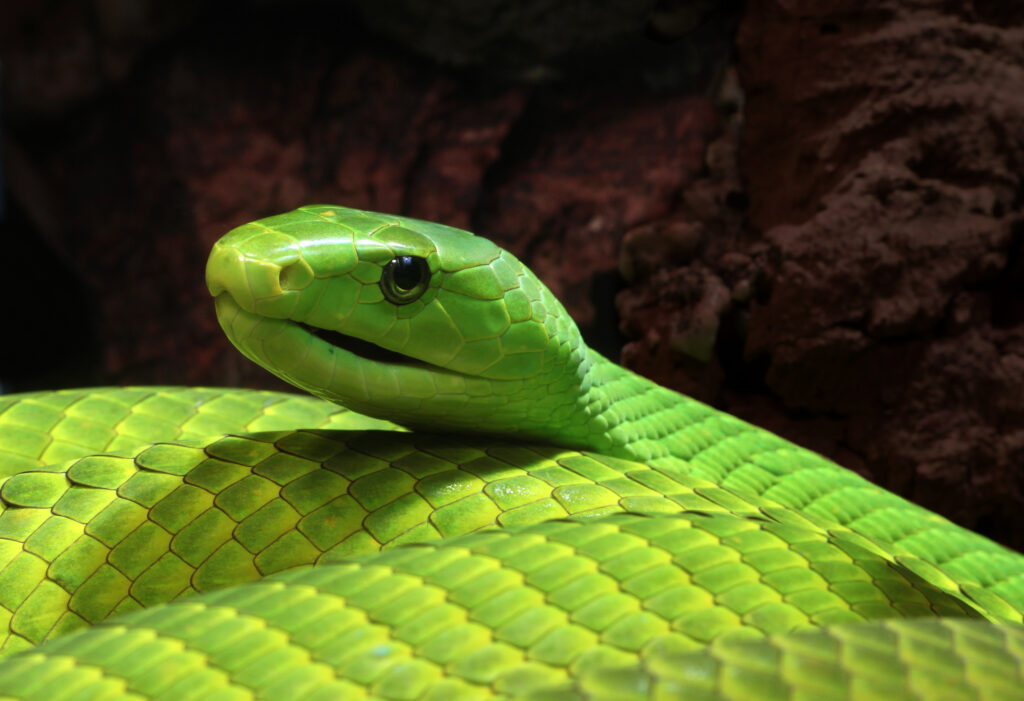
The Eastern Green Mamba is a long, slender snake with smooth scales and a distinctive bright green coloration.
It typically grows to lengths of 6-8 feet. The head is elongated, and the eyes have round pupils, unlike the elliptical pupils of many other venomous snakes.
- Region of Habitat: Coastal regions of southern East Africa
- Scientific Name: Dendroaspis angusticeps
- Place of Origin: Africa
- Feeding Habits: Carnivorous, primarily eating birds and small mammals
- What Sound They Make: Generally silent, may produce a soft hiss when threatened
Fun Facts: Eastern Green Mambas are highly venomous and considered one of Africa’s most dangerous snakes.
They are arboreal, spending most of their time in trees. Their green coloration provides excellent camouflage in their forest habitat.
Despite their reputation, they are generally shy and will try to avoid confrontation with humans.
22. Eastern Hognose Snake
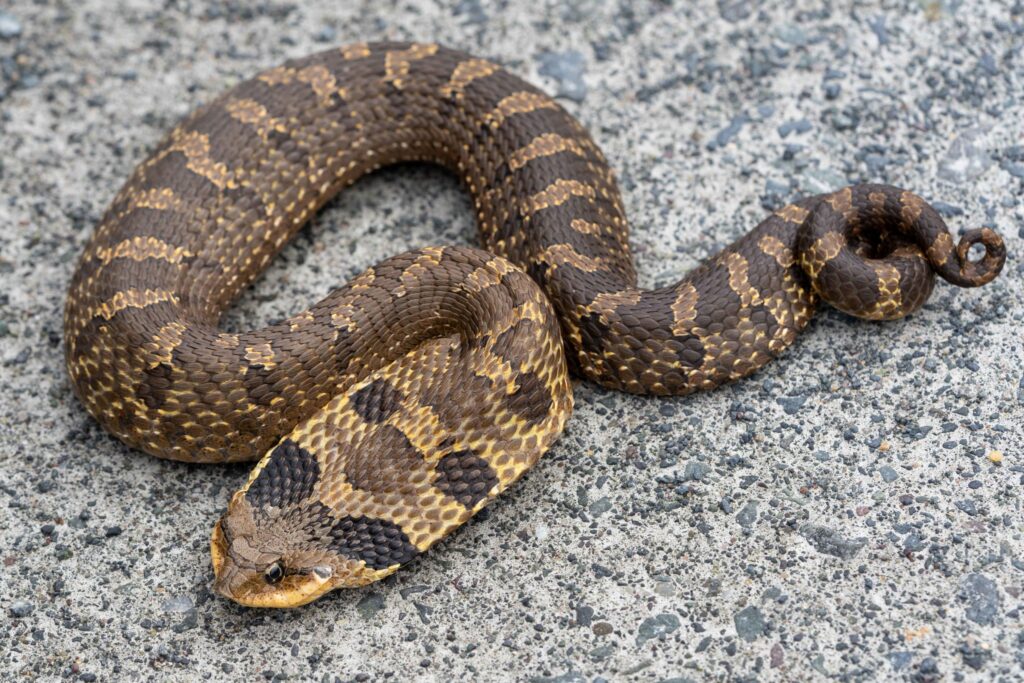
Eastern Hognose Snakes are thick-bodied snakes with a distinctive upturned snout. They typically grow to lengths of 20-33 inches.
Their coloration can vary widely, from solid black to patterns of brown, gray, or reddish blotches on a lighter background.
- Region of Habitat: Eastern United States
- Scientific Name: Heterodon platirhinos
- Place of Origin: North America
- Feeding Habits: Carnivorous, primarily eating toads and frogs
- What Sound They Make: Can produce a loud hiss when threatened
Fun Facts: Eastern Hognose Snakes are famous for their dramatic defensive displays.
When threatened, they may flatten their neck like a cobra, hiss loudly, and even play dead by rolling onto their back with their mouth open.
Despite this intimidating behavior, they are generally harmless to humans. Their upturned snout is used for digging and hunting prey.
23. Eastern Indigo Snake

The Eastern Indigo Snake is the longest native snake in North America, reaching lengths of up to 8.5 feet.
Its smooth, glossy scales are typically uniform blue-black, giving them a beautiful iridescent sheen. The chin and throat are often reddish or orange.
- Region of Habitat: Southeastern United States
- Scientific Name: Drymarchon couperi
- Place of Origin: North America
- Feeding Habits: Carnivorous, eating a variety of prey, including other snakes
- What Sound They Make: They can produce a chicken-like clucking sound when handled.
Fun Facts: Eastern Indigo Snakes are non-venomous and are known for their docile nature towards humans.
They are immune to the venom of pit vipers and often prey on rattlesnakes and copperheads.
These snakes play an important role in maintaining the balance of their ecosystems.
Unfortunately, they are currently listed as a threatened species due to habitat loss and collection for the pet trade.
24. Eastern Kingbird
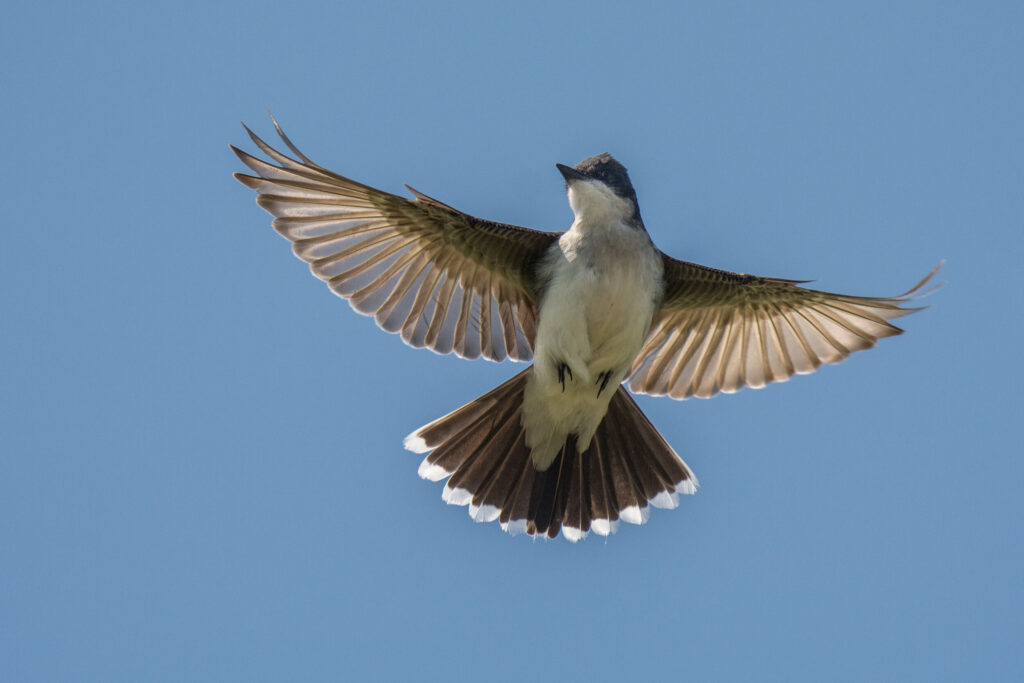
Eastern Kingbirds are medium-sized flycatchers with dark gray upperparts and white underparts. They have a distinctive white band at the tip of their tail.
Adults typically measure 7.5-9 inches long and have a wingspan of about 14-15 inches. They weigh between 1.2-1.9 ounces.
- Region of Habitat: North and South America
- Scientific Name: Tyrannus tyrannus
- Place of Origin: North America
- Feeding Habits: Primarily insectivorous, also eat some fruits
- What Sound They Make: Sharp, electric-sounding calls and twitters
Fun Facts: Eastern Kingbirds are known for their aggressive behavior, often attacking much larger birds that enter their territory.
They have a hidden crown of yellow, orange, or red feathers that they can display when excited.
These birds are monogamous, and both parents help care for their young. During winter, they migrate to South America, where they live in flocks and eat mostly fruit.
25. Eastern Lowland Gorilla
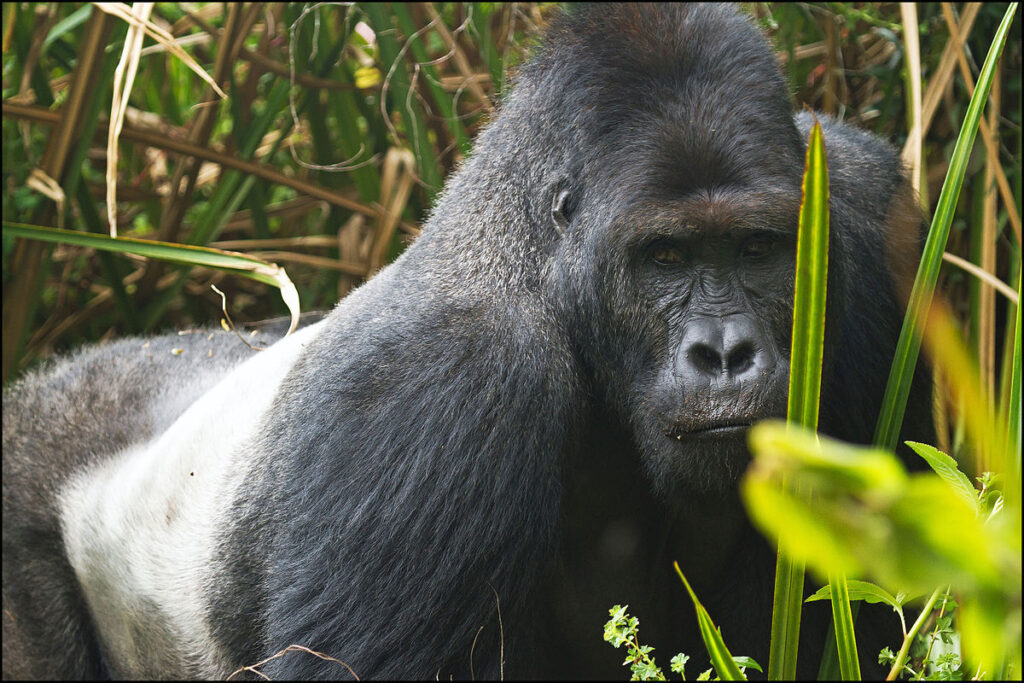
The largest gorilla subspecies are Eastern Lowland Gorillas or Grauer’s Gorillas.
Adult males can reach heights of up to 5.5 feet when standing and weigh up to 440 pounds.
Females are smaller, typically weighing around 220 pounds. They have black fur, a broad chest, and a large, rounded head.
- Region of Habitat: Eastern Democratic Republic of Congo
- Scientific Name: Gorilla beringei graueri
- Place of Origin: Africa
- Feeding Habits: Primarily herbivorous, eating leaves, fruits, and sometimes small insects
- What Sound They Make: Various vocalizations, including grunts, roars, and screams
Fun Facts: Eastern Lowland Gorillas are critically endangered, with fewer than 3,800 individuals left in the wild. They live in family groups led by a dominant silverback male.
Compared to other gorilla subspecies, these gorillas have longer limbs and a shorter, darker coat. They play a crucial role in seed dispersal in their forest habitats.
26. Eastern Meadowlark

Eastern Meadowlarks are medium-sized birds with a stocky build and a short tail.
They have brown-streaked upperparts and a bright yellow underside with a distinctive black “V” on the chest.
Adults typically measure 7.5-10 inches in length and have a wingspan of 13-15 inches. They weigh between 3.2-5.3 ounces.
- Region of Habitat: Eastern and Central North America
- Scientific Name: Sturnella magna
- Place of Origin: North America
- Feeding Habits: Omnivorous, eating insects and seeds
- What Sound They Make: Clear, whistling song often described as “spring-of-the-year”
Fun Facts: Despite their name, Eastern Meadowlarks are not larks but members of the blackbird family.
They are known for their beautiful, flute-like song. These birds build their nests on the ground, often with a dome of woven grasses and a side entrance. Eastern Meadowlarks can live up to 10 years in the wild.
27. Eastern Phoebe
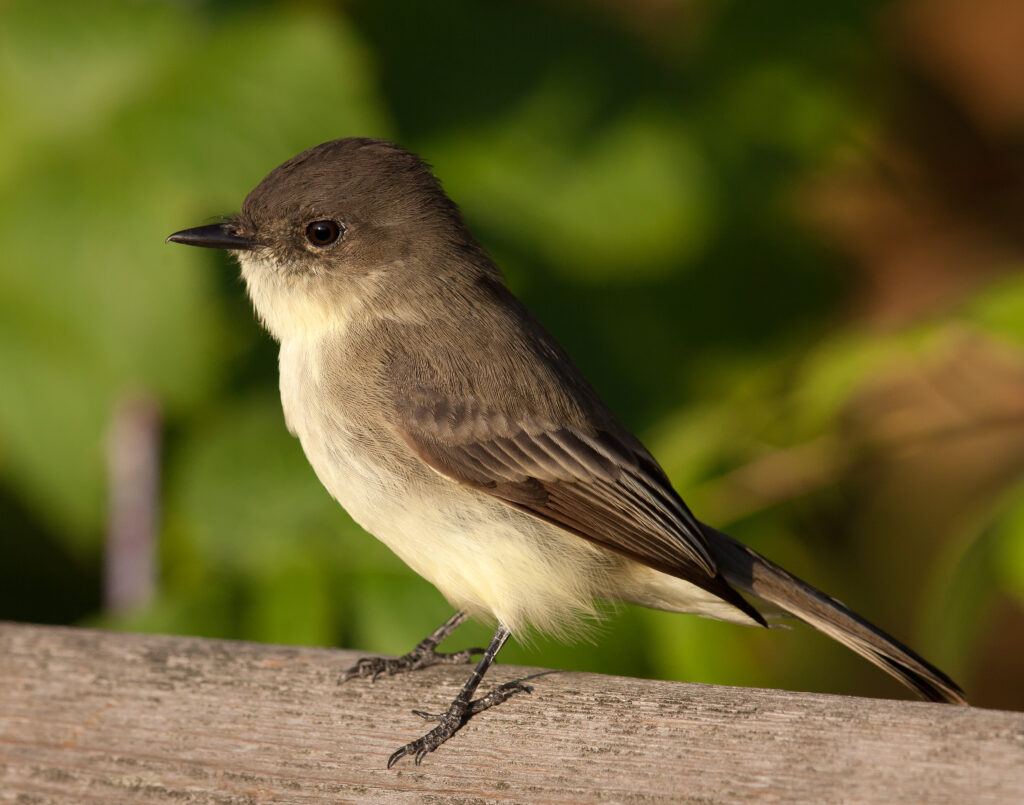
Eastern Phoebes are small songbirds with a large head and a slightly elongated, flycatcher-like bill.
They have grayish-brown upper parts and light underparts with a hint of yellow.
Adults typically measure 5.5-6.7 inches in length and have a wingspan of about 10-11 inches. They weigh between 0.6-0.7 ounces.
- Region of Habitat: Eastern and Central North America
- Scientific Name: Sayornis phoebe
- Place of Origin: North America
- Feeding Habits: Primarily insectivorous
- What Sound They Make: A raspy “fee-bee” call that gives them their name
Fun Facts: Eastern Pheasants are one of the few bird species that can learn their song without ever hearing another bird vocalize it.
They often build their nests on human-made structures like bridges and buildings. These birds are known for repeatedly wagging their tails while perched.
Eastern Pheasants are one of the earliest returning migrants in spring.
28. Eastern Rat Snake

Eastern Rat Snakes are large, non-venomous snakes that can grow up to 6-8 feet long.
Adults are usually black with white or yellowish bellies, while juveniles have a pattern of gray or brown blotches on a lighter background. They have smooth scales and a slightly flattened head.
- Region of Habitat: Eastern United States
- Scientific Name: Pantherophis alleghaniensis
- Place of Origin: North America
- Feeding Habits: Carnivorous, primarily eating rodents and birds
- What Sound They Make: Can produce a low hiss when threatened
Fun Facts: Eastern Rat Snakes are excellent climbers and can often be found in trees or scaling the sides of buildings.
They play an important role in controlling rodent populations. When threatened, these snakes may vibrate their tails, mimicking a rattlesnake.
Despite their large size, Eastern Rat Snakes are generally docile and rarely bite humans.
29. Eastern Tiger Snake

Eastern Tiger Snakes are highly venomous snakes with thick bodies and small, distinct heads. They typically grow to lengths of 3-4 feet.
Their coloration can vary widely, from olive to black, often with lighter-colored bands, giving them a tiger-like appearance.
- Region of Habitat: Southeastern Australia
- Scientific Name: Notechis scutatus
- Place of Origin: Australia
- Feeding Habits: Carnivorous, eating frogs, lizards, birds, and mammals
- What Sound They Make: Can produce a warning hiss when threatened
Fun Facts: Eastern Tiger Snakes are among the most venomous snakes in the world. They have excellent eyesight, although interestingly, more than 10% are blind in at least one eye.
These snakes are known for their defensive behavior, which involves flattening their necks and raising their heads off the ground when threatened.
Despite their dangerous reputation, they generally try to avoid confrontation with humans.
30. Echidna
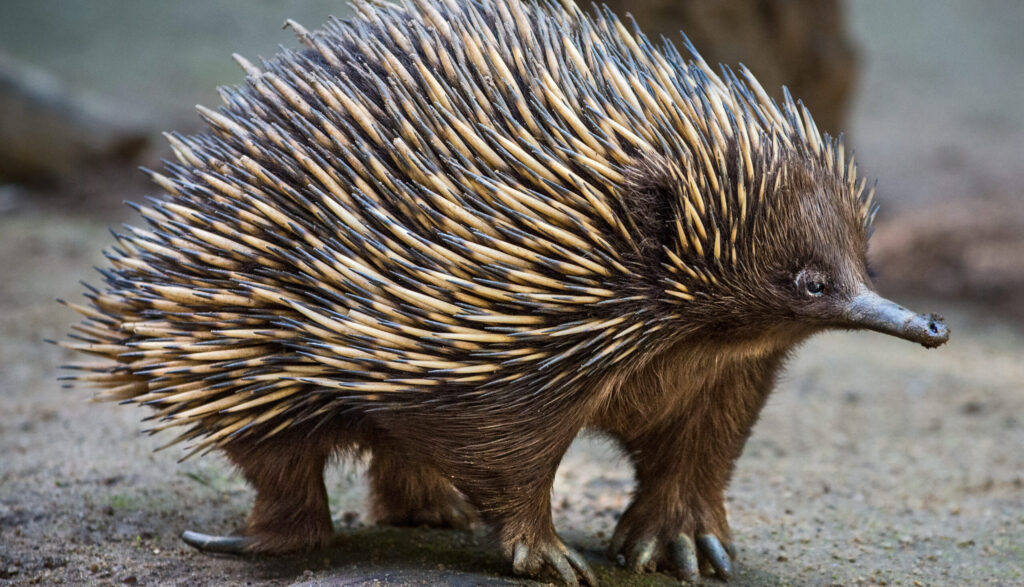
Echidnas, also known as spiny anteaters, are unique egg-laying mammals. They have a stocky body covered in coarse hair and spines, a long snout, and a specialized tongue for catching ants and termites. Adults typically measure 12-18 inches in length and weigh between 4-15 pounds.
- Region of Habitat: Australia and New Guinea
- Scientific Name: Tachyglossidae family (includes several species)
- Place of Origin: Australia and surrounding islands
- Feeding Habits: Insectivorous, primarily eating ants and termites
- What Sound They Make: Generally quiet, may produce soft grunts or snuffles
Fun Facts: Echidnas are one of only two types of mammals that lay eggs (the other being the platypus).
They have electroreceptors on the end of their snout to help detect prey. Echidnas can live up to 50 years in the wild.
When threatened, they can curl into a spiny ball for protection or quickly dig into the ground, exposing only their spines.
Conclusion
As we wrap up our exploration of animals with E, it’s clear that nature’s diversity is limitless.
From eagles soaring high above to earthworms burrowing below, these creatures each play a unique role in their ecosystems.
The animals we’ve discovered, from the endangered eastern lowland gorilla to the common eastern gray squirrel, remind us of the importance of conservation efforts worldwide.
Learning about these glamorous creatures deepens our appreciation for our planet’s intricate web of life.
Whether the electric eel’s shocking abilities or the echidna’s unusual egg-laying trait, animals with E continue to surprise and delight us.
What’s your favorite animal beginning with E? Share your thoughts in the comments below.
Don’t forget to explore our other articles about amazing animals from different parts of the alphabet!
















